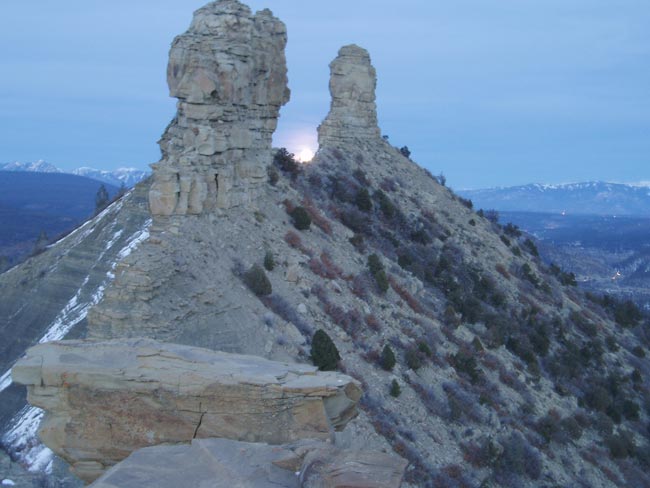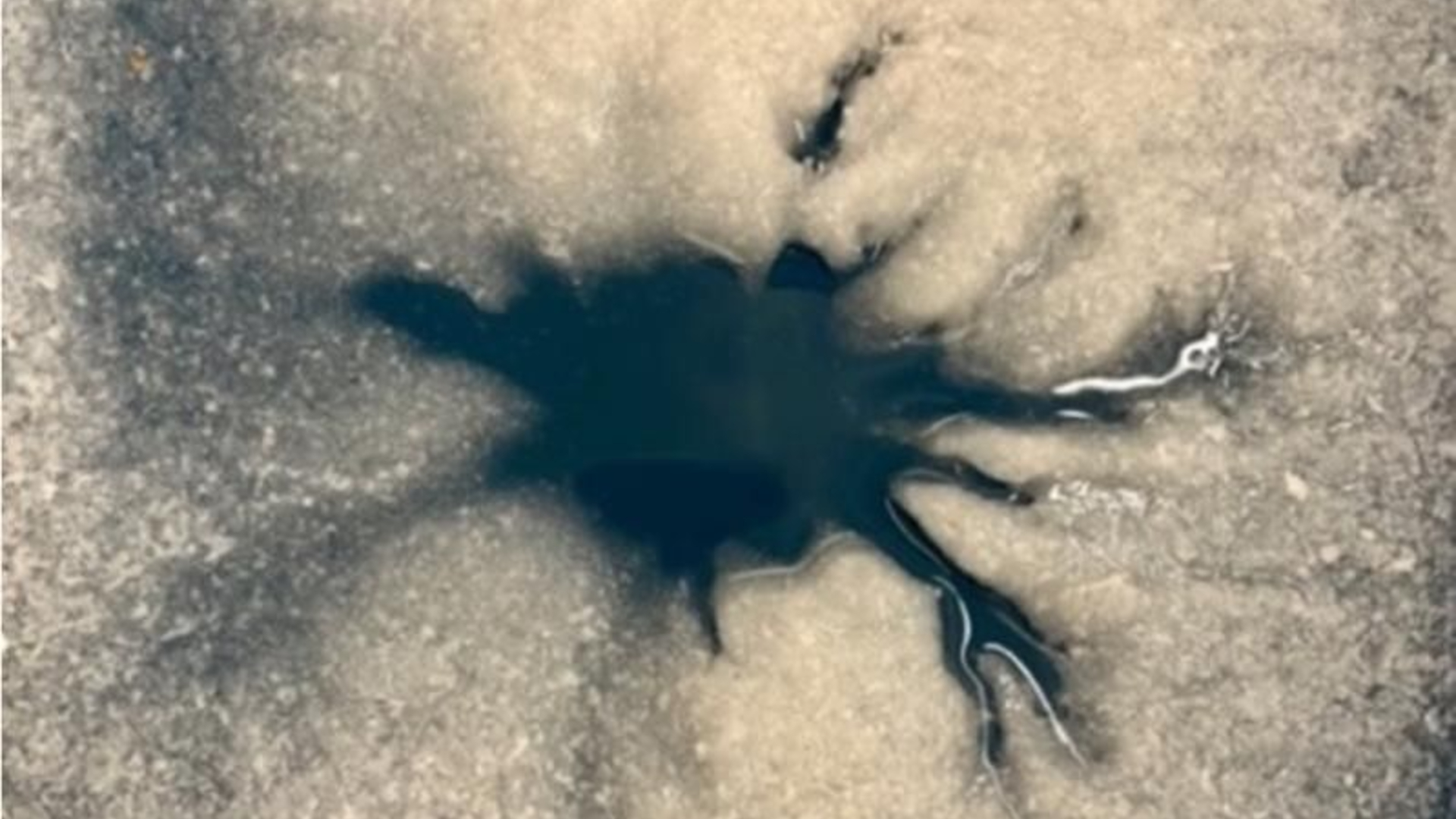'Standstill' My Beating Heart: A Lunar Love Affair

Two lovers, athousand miles apart and yearning to be back in each other's arms, may find a rayof comfort as they gaze upon the same Moon,knowing that they are bathing together in celestial light from the samesource.
Or more likely in the modern world, our lovers will "IM"their terms of endearment while bathing in the light of their LCD displays, blissfullyoblivious to what the Moon is doing. Of course the SETI Institute (which Irecently joined) is building the Allen Telescope Array to pick upNot-So-Instant Messaging from interstellar technologists.
Certainly I am much involved with the technology of moderncommunication, and I do appreciate its power to keep me on the pulse of personal,worldly, and extra-terrestrial affairs.
Yet this past year I decided to spend some substantial timeaway from the clicks, bleeps, and ring tones that pervade modern living. Itraveled out to sea, and to remote, desert locations like Chaco Canyon and Chimney Rock.
Cell phones and Internet connections don't work well in themidst of seas and deserts, but there are other forms of connection that do. Imade real contact with a time when humans were keen observers of the sky and livedin closer communion with their cosmos.
For example, one night I was astonished to realize that thesubtle glow I was discerning on the horizon was not the ubiquitous lightpollution of yonder city, but the MilkyWay rising!
This grand display of a spiral arm was profoundly alluring, sowho could have predicted that my travels would sweep me into a serious, new love affairwith a more commonly seen celestial companion - the Moon.
Breaking space news, the latest updates on rocket launches, skywatching events and more!
Yes, I confess that I have been communing unabashedly withthe "Man in the Moon"--watching him with my naked eyes and sensing the way hedraws me closer to the pulse of cosmic affairs. And yes, he does go throughphases--a sign of inconstancy for some-- but I love the drama of his waxing andwaning and have come to adore his evocative ways. He's truly an amazing dancer.
My lunarlove affair ignited last spring aboard an Italian cruise ship. We sailed to themiddle of the Mediterranean where I basked for awhile in his fleeting shadow.What a potent moment as he blocked the light of the mighty Sun at midday. Such a heartthrob!
After the voyage, I learned that I was not alone in my loverlylunacy. One of my chums--a writer for Astronomy Magazine--had proposed marriageto his lady during those few minutes of total solareclipse. Evidently this literally Sun-crossed couple chose to transcend anypre-modern superstition of foreboding, and to include the joys of traditionalsky watching with the happy moment of their engagement.
A couple of months later, I made a challenging, 4-wheeldrive to a remote, high-desert canyon in the American southwest. Chaco Culture National Historical Park is probably best known for the Sun Dagger ancientobservatory atop its most prominent geological feature--Fajada Butte. It is alsofamous for a "supernova" pictograph, which may well be a rock art recording ofthat 1054 AD apparition by a Chacoan observer.
Chacois a land of extremes--over 100 degrees Fahrenheit in July and below zero inJanuary. May had seemed to me a fine month to carry out a mission to discover howmy role as a regional representative of NASA space science might be of serviceto the Chaco interpretive staff. I had no idea that my Man in the Moonwould be waiting there to further seduce me.
Shortly after I arrived in the Park, the Moon made his move. I watched him arisefrom behind a glorious redmound of rock, eventually presenting his splendid fullness soon after sundown(see photo). I felt that same cosmic heartthrob.
Now wait a minute. How could a simple event like a full moonriseat sunset hold such sway? I diverted my energy to designing how such a momentmight be explained efficiently to Park visitors, and to determining which NASAeducational materials might be best suited to the occasion.
But the Moon was not done with me.
An interpretive ranger, by the curious name of GB Cornucopia,happened to be leading a "Moonwalk" that evening, which included a sunset tourof Pueblo Bonito - the largest and most renowned example of Chaco'sextraordinary sandstone architecture.
As I followed the tour, I was certainly not expecting GB'sastronomical commentary to be of any news to me. After all, I held a doctoraldegree in astrophysics and had taught modern astronomy for many years. I wasthere to serve GB, not the other way around. How delightful then, when suchhubris was duly humbled with a dose of traditional knowledge that would turn mygrowing attraction to the Moon into a full-blown, passionate obsession.
GB told the assembled visitors how moonrises move north andsouth on the horizon during a single month, just as the sunrises do over thecourse of a year. Further inquiry revealed that the north-south extremes ofthis monthly excursion vary over an 18.6-year "lunar standstill cycle".
Now here's the big news. We are currently in the midst of a "majorlunar standstill season" (2004-2007). This presents rare opportunities todirectly experience the most northerly and southerly moonrises in 18.6 years andto attune to the sorts of observations made by the sky watchers of Chaco and many other ancient cultures around the world. Each month in this 3-year "season",the Moon outdoes the mighty Sun (here again) by rising and setting farthernorth and south than the Sun at its solstice extremes.
Be "standstill" my beating heart. Why hadn't I ever heardabout this? I was crazy with curiosity, and there's nothing like a littlemystery to enhance romantic interest.
I began to commune with those who investigate how to readthe messages of astronomical observations and knowledge that were encoded andlaunched through time in Chacoan architecture and rock art. One of thesearchaeo-astronomers, Ron Sutcliffe, suggested a sacred tryst with the Moonin December at a place 100 miles north of Chaco, called Chimney Rock.
At Chimney Rock, my heart irresistibly opened as my full Manin the Moon, in one of his most dramatic northernmost apparitions in 18.6years, rose between two magnificent rock pillars (see photo). This spectacle,sacred to both ancestral and modern Puebloan people, is possible only during amajor lunarstandstill season.
My former ignorance of the lunar standstill cycle is widelyshared among modern astronomers, astronomy educators, and lunar explorers.Though they may well be aware of its abstract causes (namely the 5.1-degreeinclination of the Moon's orbit to the ecliptic, and the slow regression of thelunar nodes), they are inattentive to how these facts affect naked eyeobservations of the Moon's monthly dance on the horizon.
My evidence? During my workshops and presentations in thepast nine months I have asked them. My polling sample includes a team ofinstrument scientists associated with the 2008 U.S. mission to the Moon (theLunar Reconnaissance Orbiter), and over 100 scientists, engineers, and spacelawyers at the recent International Space University symposium whose theme wasto address the fundamental question confronting modern exploration: "Why theMoon?"
Modern ways seem to have eclipsed our traditional awareness ofhow the Moon behaves in the sky. So, I say why not enrich ourselves with bothmodes of exploring?
I know, I know...they say the proverbial Man in theMoon is a classic example of pareidolia--apsychological phenomenon involving a vague and random stimulus beingmistakenly perceived as somethingrecognizable. I find this highly reminiscent of modern romance.
Meanwhile, my more traditional, naked-eye indulgences thispast year have moved me to accept an invitation to a life-long relationship. Iadore the way watching my Man in the Moon draws me closer to the pulse of cosmicaffairs, both ancient and modern, and I won't give it up.
Last Saturday, I watched him from the foothills of Colorado as he arose--a pinkly apparition of a partially eclipsed full Moon. I took out mycell phone and called all my beloveds,urging them to watch with me.
- SETI: Search for Life
- Top 10 Cool Moon Facts
- Skywatcher's Guide to the Moon
- Images: Moon, Mars and Beyond
- Future Vision: Lunar Base Images
- Video: A New Era of Space Exploration
